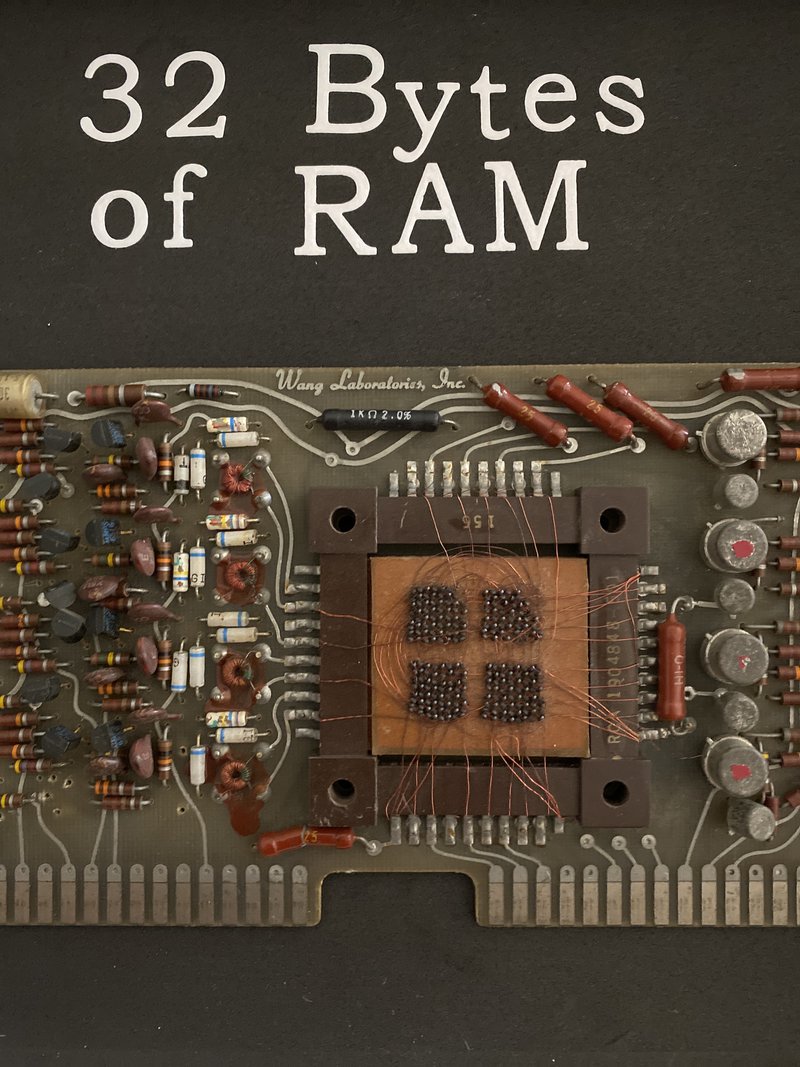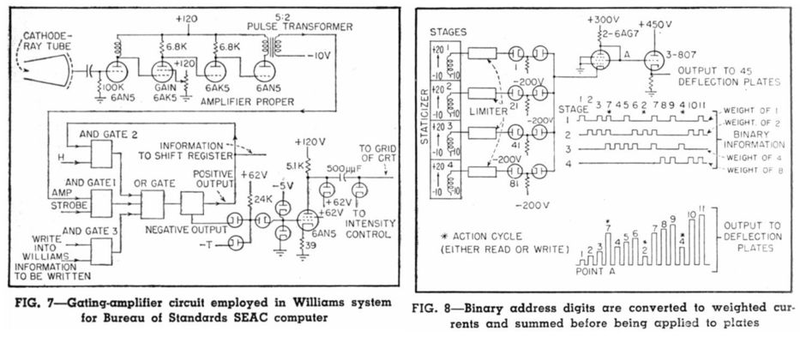
 Have you tried played around with any other types of vintage computer memory? Drum memory seems to have been the primary memory used until core memory became viable, but Williams Tubes were also super interesting.
Have you tried played around with any other types of vintage computer memory? Drum memory seems to have been the primary memory used until core memory became viable, but Williams Tubes were also super interesting.
![]() No, the audio was standard amplifier, the core was used to remember which songs you selected.
No, the audio was standard amplifier, the core was used to remember which songs you selected.
 aha, gotcha
aha, gotcha
![]() I really miss have a jukebox and a pinball machine, must do that again!
I really miss have a jukebox and a pinball machine, must do that again!
![]() The neighborhood kids loved them, and when one turned to crime he burglarized other homes, but not ours.
The neighborhood kids loved them, and when one turned to crime he burglarized other homes, but not ours.
 Silly question, although it says the cores are ferrite which does sound to be rust mixed with another metal, would straight iron not work as a core? or is there something about the ferrite being suspended in another metal, that lets it change magnetisation?
Silly question, although it says the cores are ferrite which does sound to be rust mixed with another metal, would straight iron not work as a core? or is there something about the ferrite being suspended in another metal, that lets it change magnetisation?
 Does anyone know any examples of living organisms that use a core memory model?
Does anyone know any examples of living organisms that use a core memory model?
 @anfractuosity "core memory for audio" got me thinking about using delay line memory in air to somehow make sounds... basically what you "store" in the delay line is what you are hearing at any one moment, if I understand how it works.
@anfractuosity "core memory for audio" got me thinking about using delay line memory in air to somehow make sounds... basically what you "store" in the delay line is what you are hearing at any one moment, if I understand how it works.
 @Ken Berkun Another reason to like jukeboxes in my mind. Another member, Joe Watson, shared that jukebox usage with me.
@Ken Berkun Another reason to like jukeboxes in my mind. Another member, Joe Watson, shared that jukebox usage with me.
![]() I don't know if this is the exact model I had, but it looked a lot like this: https://homebuilding.thefuntimesguide.com/seeburg_jukebox_restoration/
I don't know if this is the exact model I had, but it looked a lot like this: https://homebuilding.thefuntimesguide.com/seeburg_jukebox_restoration/
 @Andy Oliver This sounds really similar to the feedback loops some artists use (I'm thinking specifically of Mick Gordon). They play a sine wave out a speaker into a microphone that creates a slight delay (and a boat load of distortion)
@Andy Oliver This sounds really similar to the feedback loops some artists use (I'm thinking specifically of Mick Gordon). They play a sine wave out a speaker into a microphone that creates a slight delay (and a boat load of distortion)


 @Andy Oliver that sounds intriguing, probably not what you mean, but you can get a thing for guitars that is like a big spring, that acts like a delay line for audio iirc
@Andy Oliver that sounds intriguing, probably not what you mean, but you can get a thing for guitars that is like a big spring, that acts like a delay line for audio iirc
 the spring is usually used for reverb
the spring is usually used for reverb
 @Kelly Heaton it's about 59 olympic pools full of hand-woven core memory BTW
@Kelly Heaton it's about 59 olympic pools full of hand-woven core memory BTW

CHI-2018-Core-Memory.pdf
1 MB
 @Kelly Heaton Have you see this core memory quilt work?
@Kelly Heaton Have you see this core memory quilt work?
 ah so it is @morgan
ah so it is @morgan
 Thanks so much @Andy Geppert - I have to go but it has been very inspirational. Good luck, I'll enjoy following your progress.
Thanks so much @Andy Geppert - I have to go but it has been very inspirational. Good luck, I'll enjoy following your progress.
 @Andy Geppert I have not seen it work -- thanks for bringing the project to my attention!
@Andy Geppert I have not seen it work -- thanks for bringing the project to my attention!
And 59 olympic pools full of hand-woven core memory sounds like a world heritage site for sure. Great art installation for the desert: go visit the pyramids, then hop over to the core memory pools...
 @Usagi Electric (David) Thanks for the tip on Jerry Walker's videos - will check that out later. Ham's use ferrite that is not readily magnetizeable, and that is different from the kind in core memory. I don't know the technical terms for the differences.
@Usagi Electric (David) Thanks for the tip on Jerry Walker's videos - will check that out later. Ham's use ferrite that is not readily magnetizeable, and that is different from the kind in core memory. I don't know the technical terms for the differences.
 @Tony Robinson Thanks for being a part of the conversation. Fun stuff.
@Tony Robinson Thanks for being a part of the conversation. Fun stuff.
 oh that's very interesting re. there being different types of ferrites that aren't magetisable
oh that's very interesting re. there being different types of ferrites that aren't magetisable
 Copy that! Jerry does excellent videos, but sometimes his voice is a little too calm and I fall asleep, haha.
Copy that! Jerry does excellent videos, but sometimes his voice is a little too calm and I fall asleep, haha.
 @Usagi Electric (David) I have not experimented with other forms... yet.
@Usagi Electric (David) I have not experimented with other forms... yet.
 That's fair enough, vintage memory is a rabbit hole of epic proportions
That's fair enough, vintage memory is a rabbit hole of epic proportions
 Rabbit, lol
Rabbit, lol
![]() I don't see this mentioned, but Ken Sherrif did a terrific series on the Apollo guidance system that use core memory "ropes", even doing Bitcoin mining: http://www.righto.com/2019/07/bitcoin-mining-on-apollo-guidance.html (sorry if this is a dupe)
I don't see this mentioned, but Ken Sherrif did a terrific series on the Apollo guidance system that use core memory "ropes", even doing Bitcoin mining: http://www.righto.com/2019/07/bitcoin-mining-on-apollo-guidance.html (sorry if this is a dupe)
 Can't find it above, but someone asked about visualizing mercury delay line memory. I think a long spring, per that reverb discussion, could be an ideal way to do that. Induce a physical pulse in one end of a spring, wait for it to propagate to the other end, pick up the pulse, then send it again from the first end. Might need to add some foam or rubberized coating to the spring to dampen it and prevent too much "reverb." Not sure I am describing that well, but it seems possible and I can image the "ah ha" on people's faces when they see the demo.
Can't find it above, but someone asked about visualizing mercury delay line memory. I think a long spring, per that reverb discussion, could be an ideal way to do that. Induce a physical pulse in one end of a spring, wait for it to propagate to the other end, pick up the pulse, then send it again from the first end. Might need to add some foam or rubberized coating to the spring to dampen it and prevent too much "reverb." Not sure I am describing that well, but it seems possible and I can image the "ah ha" on people's faces when they see the demo.
 Has anyone tried implementing spatial core memory? Not for the usual computer science reasons, but to create an addressable (and shapeable) magnetic field with 3D topology?
Has anyone tried implementing spatial core memory? Not for the usual computer science reasons, but to create an addressable (and shapeable) magnetic field with 3D topology?
 Oh yes - I have been inspired A LOT by Ken and the team's videos with the AGC.
Oh yes - I have been inspired A LOT by Ken and the team's videos with the AGC.
![]() In replyu to Kelly Heaton's question about core in living things, yes: https://www.accessscience.com/content/ferritin-iron-storage-in-biological-systems/YB150546
In replyu to Kelly Heaton's question about core in living things, yes: https://www.accessscience.com/content/ferritin-iron-storage-in-biological-systems/YB150546
 @Ken Berkun awesome! Thank you!!
@Ken Berkun awesome! Thank you!!
![]() Ken S. is great, super nice guy, too.
Ken S. is great, super nice guy, too.
 @Ken Berkun whoa amazing.
@Ken Berkun whoa amazing.
 There are also a wide range of core memory implementations. By no means do I know them all. Recently, and
There are also a wide range of core memory implementations. By no means do I know them all. Recently, and
[Joe Watson] (Hackaday reader) shared a project post where he reverse-engineers a clever implementation of core memory with a minimal amount of driver circuitry in the form of the IBM 1620 Core Stack at: https://www.angelfire.com/oh3/ebjoew/IBM_1620_Core_Memory.html
Joe said, “The clever designers of the IBM 1620 managed to create a design that needed no bidirectional transistor-based drivers whatsoever and a very minimal number of drivers at that.”
Joe’s write-up also points out another core memory form: “I have also seen some such cores that were constructed of a plastic bobbin with a ribbon of some shiny alloy wrapped many times around them.” Has anyone here worked with that form of core memory?
![]() The world is amazing
The world is amazing
 After I read Joe’s post, I explored more of his posts and ended up learning about the “memristor” http://sparkbangbuzz.com/memristor/memristor.htm
After I read Joe’s post, I explored more of his posts and ended up learning about the “memristor” http://sparkbangbuzz.com/memristor/memristor.htm
If I understand correctly, a memristor “remembers” which way a current was flowing when it was set. The “read” is done by pushing a much smaller current through the memristor, and whether or not the resistance is high or low indicates the state of the memristor.
It sounds like the actual workings and definition of the memristor are still hot topics, and it might still become a viable memory type in the near future. (https://en.wikipedia.org/wiki/Memristor)
One of the striking things about this kind of memory is that the behavior was predicted by recognizing the relationships between capacitors, resistors, inductors, and theorizing that a four fundamental component could be inferred with “maths.”
 The fourth component being "memristor."
The fourth component being "memristor."
 @Andy Geppert memristor might be my new favorite word
@Andy Geppert memristor might be my new favorite word
 Regular analog delay lines made with springs, plates, and bucket-brigade delay chips are a thing in music... and I didn't know about people tapping into them to make crazy sounds like @Usagi Electric (David) mentioned. The positive feedback is the thing here to keep the memory live. So that might also be the way to "hear" what memory might sound like, at least if the memory is operating at audio frequencies.
Regular analog delay lines made with springs, plates, and bucket-brigade delay chips are a thing in music... and I didn't know about people tapping into them to make crazy sounds like @Usagi Electric (David) mentioned. The positive feedback is the thing here to keep the memory live. So that might also be the way to "hear" what memory might sound like, at least if the memory is operating at audio frequencies.
 I've always been curious to see what CRT-based memory "looks" like. Can you watch the memory on a CRT system?
I've always been curious to see what CRT-based memory "looks" like. Can you watch the memory on a CRT system?
 I am in awe of people who can see the world through math/physics and predict things that haven't been discovered... and then they are found. Sometimes decades or centuries later!
I am in awe of people who can see the world through math/physics and predict things that haven't been discovered... and then they are found. Sometimes decades or centuries later!
 CRT RAM system I mean?
CRT RAM system I mean?
 @Andy Geppert can you link to the article about whoever predicted with memristor with math?
@Andy Geppert can you link to the article about whoever predicted with memristor with math?
 @Andy Oliver Yeah, I wonder that too. I think there is a plate that usually covers the face of the CRT though. But even a simulation of that type of memory, perhaps not being real, would still be very cool and an effective way to understand that tech better.
@Andy Oliver Yeah, I wonder that too. I think there is a plate that usually covers the face of the CRT though. But even a simulation of that type of memory, perhaps not being real, would still be very cool and an effective way to understand that tech better.
 Yes, CRT memory is visible :
Yes, CRT memory is visible :
https://twitter.com/TubeTimeUS/status/1441871617638887425?s=20


 @Kelly Heaton I think there are two people, and maybe articles linked from in here https://en.wikipedia.org/wiki/Memristor
@Kelly Heaton I think there are two people, and maybe articles linked from in here https://en.wikipedia.org/wiki/Memristor
 @Andy Oliver I believe you're referring to Williams tubes. There is a plate in front of the CRT, but without that plate, the memory is usually visible as Muth showed with TubeTime's tweet
@Andy Oliver I believe you're referring to Williams tubes. There is a plate in front of the CRT, but without that plate, the memory is usually visible as Muth showed with TubeTime's tweet
 Holy cow, I just looked at the clock and saw that we whipped through the hour. I know Andy said he has some more time, so if you want to keep chatting, that's what we're here for. Otherwise, I'll just say an official "Thanks, Andy!" and wish everyone who can't stick around well. And thanks for coming, of course!
Holy cow, I just looked at the clock and saw that we whipped through the hour. I know Andy said he has some more time, so if you want to keep chatting, that's what we're here for. Otherwise, I'll just say an official "Thanks, Andy!" and wish everyone who can't stick around well. And thanks for coming, of course!
 @Usagi Electric (David) I'll go take a look if I can scroll up.
@Usagi Electric (David) I'll go take a look if I can scroll up.
 @Andy Geppert absolutely fascinating! Thank you!! Good luck with your electrical weaving and memory
@Andy Geppert absolutely fascinating! Thank you!! Good luck with your electrical weaving and memory
 Thanks @Andy Geppert !
Thanks @Andy Geppert !
 Thanks @Andy Geppert !
Thanks @Andy Geppert !
![]() Thanks for the great chat, sorry I had to come in late!
Thanks for the great chat, sorry I had to come in late!
 Here's Wiki's article on Williams Tubes: https://en.wikipedia.org/wiki/Williams_tube
Here's Wiki's article on Williams Tubes: https://en.wikipedia.org/wiki/Williams_tube
And here's a PDF for some patent info on them

williams_tube_patent_info.pdf
1 MB
 @Dan Maloney Thanks again for the opportunity. I'll stick around for a bit longer and try to catch up with all the fun links and questions... Thanks to everyone for your interest and contributions. I have all sort of new links to chase down and read now!
@Dan Maloney Thanks again for the opportunity. I'll stick around for a bit longer and try to catch up with all the fun links and questions... Thanks to everyone for your interest and contributions. I have all sort of new links to chase down and read now!
 Thanks Andy!
Thanks Andy!
 Thanks a lot! Was very interesting!
Thanks a lot! Was very interesting!
 (For those that don't want to download the PDF here's a block diagram of how William's Tubes work)
(For those that don't want to download the PDF here's a block diagram of how William's Tubes work)


 @Muth Hi! Good evening to you. Thanks for sharing that Williams Tube Link.
@Muth Hi! Good evening to you. Thanks for sharing that Williams Tube Link.
 @Muth finally got to the tweet you shared. Thanks. My browser kept jumping around making it hard for me to go back and see what I missed.
@Muth finally got to the tweet you shared. Thanks. My browser kept jumping around making it hard for me to go back and see what I missed.
 Any questions directed at me that I missed above? The feed moves faster than I can type!
Any questions directed at me that I missed above? The feed moves faster than I can type!
 you're welcome ! It's only by chance I remembered this tweet from tubetime, I was amazed by the technology. Sorry @Andy Geppert I came a bit late, it is very cool you could make this hackachat !
you're welcome ! It's only by chance I remembered this tweet from tubetime, I was amazed by the technology. Sorry @Andy Geppert I came a bit late, it is very cool you could make this hackachat !
 @Andy Oliver You wrote "The positive feedback is the thing here to keep the memory live." That could describe this chat session, right? :)
@Andy Oliver You wrote "The positive feedback is the thing here to keep the memory live." That could describe this chat session, right? :)
 Dan Maloney
Dan Maloney
Discussions
Become a Hackaday.io Member
Create an account to leave a comment. Already have an account? Log In.